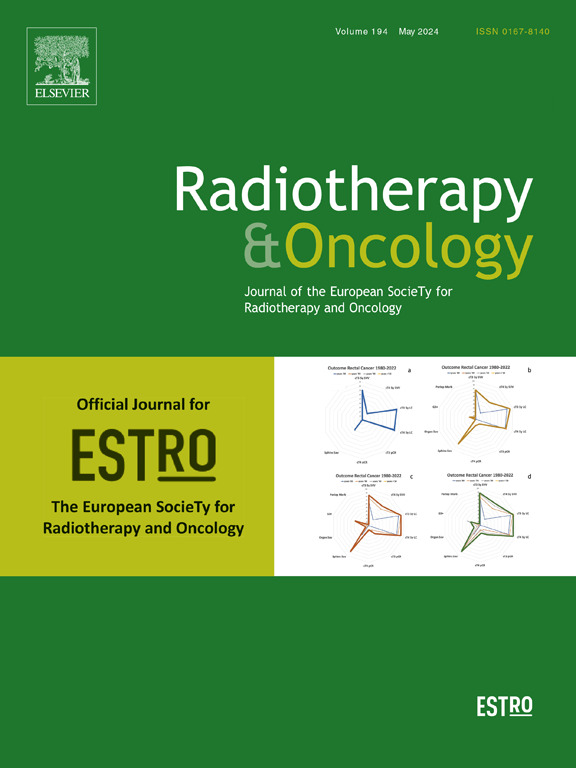利用电子和光子进行超高剂量率和常规剂量率混合治疗,将FLASH-RT应用于深部靶点的临床转移:治疗规划研究
IF 4.9
1区 医学
Q1 ONCOLOGY
引用次数: 0
摘要
目的 本研究探讨了超高剂量率(UHDR)电子和常规剂量率(CDR)光子混合放疗(HUC)的剂量学可行性和计划质量,以FLASH-RT治疗深部肿瘤。方法 对一例胶质母细胞瘤、一例胰腺癌和一例前列腺癌病例进行了超高剂量率电子束(20-250MeV)与常规剂量率光子混合放疗计划优化。HUC计划以临床处方和分层方案为基础,并与临床实施计划进行比较。结果在所有三个病例中,HUC 治疗计划的剂量质量与临床计划相当,具有相似的 PTV 覆盖率(V95% 在 0.5 % 以内)、均匀性和临界 OAR 保留率。同时,HUC 计划在 UHDR 时向 PTV(Dmedian 为 50-69%)和周围组织投放了大量剂量。对于胶质母细胞瘤的 HUC 增量治疗,第一种 FLASH 清除方案显示,15-Gy UHDR 电子增量对 FLASH 的清除程度适中(D2%,PTV 为 10%),而第二种方案显示对 PTV 内外的脑组织的清除程度更高(D2%,PTV 为 32%,D2%,Brain 为 31%)。结论从计划的角度来看,HUC 治疗是一种可行的方法,可用于进行剂量学保形 UHDR 治疗,从而有可能减轻与对深部肿瘤进行保形 FLASH-RT 治疗相关的技术挑战。虽然还需要进一步研究来优化针对特定患者群的 HUC 分层和给药方案,但 HUC 治疗为 FLASH-RT 的临床应用提供了一条前景广阔的途径。本文章由计算机程序翻译,如有差异,请以英文原文为准。
Hybrid ultra-high and conventional dose rate treatments with electrons and photons for the clinical transfer of FLASH-RT to deep-seated targets: A treatment planning study
Purpose
This study explores the dosimetric feasibility and plan quality of hybrid ultra-high dose rate (UHDR) electron and conventional dose rate (CDR) photon (HUC) radiotherapy for treating deep-seated tumours with FLASH-RT.
Methods
HUC treatment planning was conducted optimizing a broad UHDR electron beam (between 20–250 MeV) combined with a CDR VMAT for a glioblastoma, a pancreatic cancer, and a prostate cancer case. HUC plans were based on clinical prescription and fractionation schemes and compared against clinically delivered plans. Considering a HUC boost treatment for the glioblastoma consisting of a 15-Gy-single-fraction UHDR electron boost supplemented with VMAT, two scenarios for FLASH sparing were assessed using FLASH-modifying-factor-weighted doses.
Results
For all three patient cases, HUC treatment plans demonstrated comparable dosimetric quality to clinical plans, with similar PTV coverage (V95% within 0.5 %), homogeneity, and critical OAR-sparing. At the same time, HUC plans delivered a substantial portion of the dose to the PTV (Dmedian of 50–69 %) and surrounding tissues at UHDR. For the HUC boost treatment of the glioblastoma, the first FLASH sparing scenario showed a moderate FLASH sparing magnitude (10 % for D2%,PTV) for the 15-Gy UHDR electron boost, while the second scenario indicated a more substantial sparing of brain tissues inside and outside the PTV (32 % for D2%,PTV, 31 % for D2%,Brain).
Conclusions
From a planning perspective, HUC treatments represent a feasible approach for delivering dosimetrically conformal UHDR treatments, potentially mitigating technical challenges associated with delivering conformal FLASH-RT for deep-seated tumours. While further research is needed to optimize HUC fractionation and delivery schemes for specific patient cohorts, HUC treatments offer a promising avenue for the clinical transfer of FLASH-RT.
求助全文
通过发布文献求助,成功后即可免费获取论文全文。
去求助
来源期刊

Radiotherapy and Oncology
医学-核医学
CiteScore
10.30
自引率
10.50%
发文量
2445
审稿时长
45 days
期刊介绍:
Radiotherapy and Oncology publishes papers describing original research as well as review articles. It covers areas of interest relating to radiation oncology. This includes: clinical radiotherapy, combined modality treatment, translational studies, epidemiological outcomes, imaging, dosimetry, and radiation therapy planning, experimental work in radiobiology, chemobiology, hyperthermia and tumour biology, as well as data science in radiation oncology and physics aspects relevant to oncology.Papers on more general aspects of interest to the radiation oncologist including chemotherapy, surgery and immunology are also published.
 求助内容:
求助内容: 应助结果提醒方式:
应助结果提醒方式:


